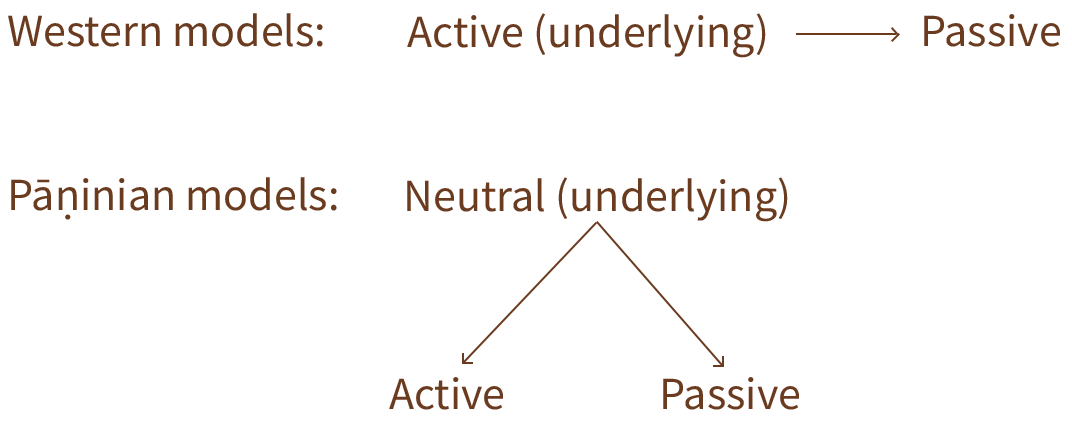Passive
1. Introduction
The term 'passive' refers to an argument structure alternation or operation common in languages with nominative-accusative morphosyntactic alignment, and to verb forms or constructions which exemplify this alternation.
In all Western approaches to the passive, it is taken as derived in some way from a more basic structure, the active. (This is even true of models explicitly influenced by Pāṇini, such as that of Kiparsky 1987, 1988, 1997, 2001.) In very basic terms, the subject of a transitive active verb is either deleted or demoted to an oblique argument role, and the object of the transitive active construction becomes the passive subject. This operation is usually marked morphosyntactically on the verb. For example:
b. PASSIVE: The mouse was seen by the cat.
2. The Indian tradition
The derivation of the passive in the Pāṇinian tradition is treated in 'Argument structure'. In contrast to all Western models, for Pāṇini the passive is not derived from the active, nor from any other more basic structure. Rather, the system is designed so that in any verbal construction there is a free choice between active and passive, which derive separately from an underlying set of relations which are entirely neutral to voice.

The Pāṇinian model implies an absolute equivalence between active and passive, since they both represent the same underlying sentence structure. However, the later tradition took different approaches to the question of the semantic correlation between active and passive. As discussed by Joshi (1993:17-18), Kauṇḍabhaṭṭa took a more traditional approach, treating active and passive as almost identical, bar the grammatical differences. So, for the sentence Caitras taṇḍulān pacati 'Caitra cooks the rice grains.', Joshi provides the following semantic paraphrase in line with Kauṇḍabhaṭṭa's view:
Ekatvāvacchinnacaitrābhinnakartṛko vartamānakālikas taṇḍulābhinnakarmaniṣṭhaviklittyanukūlaḥ phūtkārādirūpavyāpāraḥ.
'An activity in the form of blowing [on the fire] etc., of which the agent is limited by singularity and nondifferent from Caitra, belonging to the present time, and favourable to the [result, namely] the becoming soft [of the rice grains] which [result] resides in an object non-different from rice grains.'
For the corresponding passive sentence, Kauṇḍabhaṭṭa's analysis is almost identical, the only exception being that the expression of verbal agreement, which is attached to the agent in (2) [the sequence ekatvāvacchinna 'limited by singularity' at the start of (2)], is now attached to the patient (3) [the sequence bahutvāvacchinna 'limited by plurality' beginning the third word]:
caitrābhinnakartṛko vartamānakālikas bahutvāvacchinnataṇḍulābhinna-karmaniṣṭhaviklittyanukūlaḥ phūtkārādirūpavyāpāraḥ.
'An activity in the form of blowing [on the fire] etc., of which the agent is nondifferent from Caitra, belonging to the present time, and favourable to the [result, namely] the becoming soft [of the rice grains] which [result] resides in an object limited by plurality and non-different from rice grains.'
In contrast, Nāgeśabhaṭṭa offers a rather different paraphrase of the passive, treating it as semantically different from the active, despite accepting the grammatical equivalence of active and passive in the Pāṇinian system. His paraphrase of the passive, corresponding to (3), is given by Joshi (1993: 18) as follows:
caitrābhinnakartṛkavartamānakālikavyāpārajanyā bahutvāvacchinnataṇḍulābhinnakarmikā viklittiḥ.
'A becoming soft, of which the object is non-different from rice grain[s] limited by plurality, arising from an activity of the present time, of which [activity] the agent is non-different from Caitra.'
That is, for Nāgeśa the passive denotes the result of an activity (i.e. the becoming soft), in contrast to the active which denotes the activity itself (the blowing etc.).
The philosophical school of Nyāya treats not the verb, but the nominative argument (≈subject), as the primary element of meaning in a sentence. In consequence, active and passive must be semantically distinct, because the primary meaning element in a passive is different from the corresponding active (Joshi 1993: 31-32).
On the other hand, the Mīmāṃsā tradition treats active and passive as identical. Following Joshi (1993:36), the Mīmāṃsaka paraphrase for the sentence Caitro grāmaṃ gacchati 'Caitra goes to the village', and for the corresponding passive sentence, would be:
ekatvāvacchinnacaitrakartṛkā ekatvāvachinnagrāmaniṣṭhasaṃyogānukūlā vartamānakālikī bhāvanā.
'A productive operation of present time favourable to [the result] conjunction (a quality) residing in the object village which is limited by singularity, of which (productive operation) Caitra limited by singularity is the agent.'
In distinction from Kauṇḍabhaṭṭa's paraphrases, where the grammatical agreement of the verb with its subject is marked by the specification of number (ekatvāvacchinna 'limited by singularity', bahutvāvacchinna 'limited by plurality') only on the element with which the verb agrees, in the Mīmāṃsaka paraphrase both arguments appear with specification of number, meaning there is no difference between active and passive paraphrases.